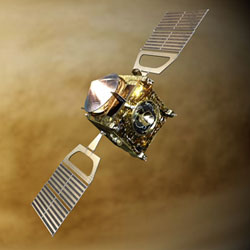
Artist illustration of Venus Express. Image credit: ESA. Click to enlarge.
University of Colorado at Boulder planetary scientist Larry Esposito, a member of the European Space Agency’s Venus Express science team, believes the upcoming mission to Earth’s “evil twin” planet should be full of surprises.
While its 875-degree F. surface is hot enough to make rocks glow and its atmosphere is filled with noxious carbon dioxide gases and acid rain, Venus actually is more Earth-like than Mars, said Esposito, a professor in CU-Boulder’s Laboratory for Atmospheric and Space Physics. A member of the Venus Monitoring Camera team for the $260 million now slated for launch from the Baikonur Cosmodrome in Kazakhstan on Nov. 9, Esposito said Venus is a “neglected planet” that undoubtedly harbors a number of astounding discoveries.
One question revolves around what is known as an “unknown ultraviolet absorber” high in the planet’s clouds that blocks sunlight from reaching the surface. “Some scientists believe there is the potential, at least, that life could be found in the clouds of Venus,” said Esposito. “There has been speculation that sunlight absorbed by the clouds might be involved in some kind of biological activity.”
Esposito is particularly eager to see if volcanoes on Venus are still active. In 1983 he used data from a CU-Boulder instrument that flew on NASA’s Pioneer Venus spacecraft to uncover evidence that a massive volcanic eruption there poured huge amounts of sulfur dioxide into the upper atmosphere. The eruption, which likely occurred in the late 1970s, appears to have been at least 10 times more powerful than any that have occurred on Earth in more than a century, he said.
“The spacecraft will be looking for ‘hotspots’ through the clouds in an attempt to make a positive detection of volcanoes,” said Esposito, who made the first observations of Venus with the Hubble Space Telescope in 1995. “While the Magellan mission that mapped Venus in the 1990s was not able to find evidence of volcanic activity, it did not close out the question. This will give us another shot.”
Since Venus and Earth were virtual twins at birth, scientists are puzzled how planets so similar in size, mass and composition could have evolved such different physical and chemical processes, he said. “The results from missions like this have major implications for our understanding of terrestrial planets as a whole, and for comparable processes occurring on Earth and Mars,” said Esposito.
Esposito has been involved in a number of planetary exploration missions at CU-Boulder. He currently is science team leader for the UltraViolet Imaging Spectrograph, a $12.5 million CU-Boulder instrument on the Cassini spacecraft now exploring the rings and moons of Saturn.
He also was an investigator for a CU-Boulder instrument that visited Jupiter and its moons in the 1990s aboard NASA’s Galileo spacecraft, and was an investigator for NASA’s Voyager 2 spacecraft that toted a CU-Boulder instrument on a tour of the solar system’s planets in the 1970s and 1980s.
Esposito was a science team member on two failed Russian missions to Mars — the 1988 Phobos mission that exploded in space and the Mars 96 mission that crashed in Earth’s ocean. Five of the science instruments on Venus Express are “spares” from the Mars Express and Rosetta comet mission, according to ESA.
In addition to the camera, the Venus Express spacecraft also is carrying two imaging spectrometers, a spectrometer to measure atmospheric constituents, a radio science experiment and a space plasma and atom-detecting instrument. The spacecraft is expected to arrive at Venus in April 2006 and orbit the planet for about 16 months.
The Venus Express mission originally was scheduled to launch Oct. 26, but a thermal-insulation problem discovered in the upper-stage booster rocket caused a two-week delay. The launch window closes on Nov. 24.
Original Source: UC Boulder News Release
